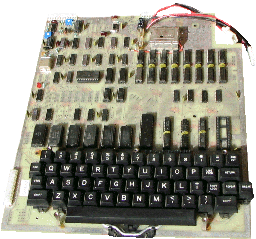To the
right, this was my first home computer, an Ohio
Scientific Superboard II. I bought this all in one
machine from someone in Würseln, a small town in
Germany, in the early 80's. Today the machine does not
exist any more only a few ROM's and some handbooks,
articles and program cassettes survived.
When in 1997 emulation became more common I started to
write my own Emulator. A Windows version of the emulator
with some updates over the last years can be downloaded
in the Software section, thanks to the continuous
interest of emulator users.
Last updated Rev 1.9c Emulator now with Sound , Color
and several
improvements managing files. YE-DOS now runs very well
in newer 1.44MB drives and on older Shugart 400. With
the latest update and on user demand, YE-DOS X now
works with standard ROM's and is only located in
the upper part of a 32k expansion (610 board for
example). There
is a 32bit and 64bit version available with a minimum
requirement of Windows 7. OSI Software files and link's have
been renewed. Recently, I had to move my OSI
homepage from SQUARE7.CH to a https Google Site and I
hope I've found a new good home for this site. Please
check out the Tools and utilites site here.

Superboard
II - Year 1977

Check out the Emulator !
How all began
After my TI-57 programmable handheld calculator the Superboard II from Ohio Scientific was my first computer. Around 1980 I got this machine, a 6502- based single-board computer with 8K of RAM and BASIC in ROM. The board needed an extra 5V, 3A power supply to run. (everything needed something extra)
The board was a revision B and had from the previous owner some enhancements in the VDU section to display the entire 32x32 characters on a standard TV monitor.
The main board design was quite simple by today's standards but the double sided board had a good quality ideal to do various modifications. The chips were 'normal' TTL and the board contained the keyboard, CPU, ROM, RAM (up to 8K on board), a video section for connection to a monitor or TV via an RF modulator, and cassette I/O.
Upon boot-up, the user was presented with a prompt for 'D/C/W/M ?' which allowed you to boot from disk, cold boot, warm boot or enter the monitor to debug machine-code programs. There was no disk drive and no integrated controller and due to the high market prices far out of reach.
